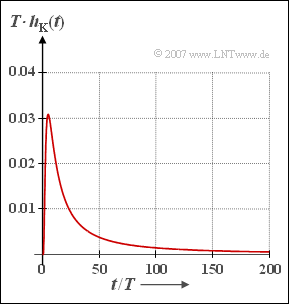Exercise 3.1: Impulse Response of the Coaxial Cable
The frequency response of a coaxial cable of length $l$ can be represented by the following formula:
- $$H_{\rm K}(f) \ = \ {\rm e}^{- \alpha_0 \hspace{0.05cm} \cdot \hspace{0.05cm} l} \cdot {\rm e}^{- (\alpha_1 + {\rm j} \hspace{0.05cm}\cdot \hspace{0.05cm} \beta_1) \hspace{0.05cm}\cdot f \hspace{0.05cm}\cdot \hspace{0.05cm}l} \cdot \ {\rm e}^{- (\alpha_2 + {\rm j} \hspace{0.05cm}\cdot \hspace{0.05cm} \beta_2) \hspace{0.05cm}\cdot \sqrt{f} \hspace{0.05cm}\cdot \hspace{0.05cm}l} \hspace{0.05cm}.$$
The first term of this equation is due to the ohmic losses, and the second term is due to the transverse losses. Dominant, however, is the skin effect, which is expressed by the third term.
With the coefficients valid for a so-called standard coaxial cable $(2.6 \ \rm mm$ core diameter and $9.5 \ \rm mm$ outer diameter$)$
- $$\alpha_2 = 0.2722 \hspace{0.15cm}\frac{\rm Np}{\rm km \cdot \sqrt{\rm MHz}} \hspace{0.05cm}, \hspace{0.2cm} \beta_2 = 0.2722 \hspace{0.15cm}\frac{\rm rad}{\rm km \cdot \sqrt{\rm MHz}}\hspace{0.05cm}.$$
this frequency response can also be represented as follows:
- $$H_{\rm K}(f) \approx {\rm e}^{- 0.2722 \hspace{0.05cm}\cdot \hspace{0.05cm}l/{\rm km} \hspace{0.05cm}\cdot \sqrt{f/{\rm MHz}} } \cdot {\rm e}^{- {\rm j}\hspace{0.05cm}\cdot \hspace{0.05cm} 0.2722 \hspace{0.05cm}\cdot \hspace{0.05cm}l/{\rm km} \hspace{0.05cm}\cdot \sqrt{f/{\rm MHz}}} \hspace{0.05cm}.$$
That means: attenuation curve $a_{\rm K}(f)$ and phase curve $b_{\rm K}(f)$ are identical except for the pseudo units "$\rm Np$" and "$\rm rad$".
If one defines the characteristic cable attenuation $a_*$ at half the bit rate $(R_{\rm B}/2)$, one can treat digital systems of different bit rate and length uniformly:
- $$a_{\star} = a_{\rm K}(f = {R_{\rm B}}/{2}) \hspace{0.3cm}\Rightarrow \hspace{0.3cm}H_{\rm K}(f) = {\rm e}^{- a_{\star} \cdot \sqrt{2f/R_{\rm B}}}\cdot {\rm e}^{- {\rm j}\hspace{0.05cm}\cdot \hspace{0.05cm} a_{\star} \cdot \sqrt{2f/R_{\rm B}}}\hspace{0.4cm}{\rm with}\hspace{0.2cm}a_{\star}\hspace{0.2cm}{\rm in}\hspace{0.2cm}{\rm Np} \hspace{0.05cm}.$$
The corresponding $\rm dB$ value is larger by a factor of $8.688$. For a binary system, $R_{\rm B} = 1/T$ applies, so that the characteristic cable attenuation is then related to the frequency $f = 1/(2T)$.
The Fourier transform of $H_{\rm K}(f)$ yields the impulse response $h_{\rm K}(t)$, which can be given in closed-analytic form for a coaxial cable with the approximations described here. For a binary system holds:
- $$h_{\rm K}(t) = \frac{ a_{\star}/T}{ \sqrt{2 \pi^2 \cdot (t/T)^3}}\hspace{0.1cm} \cdot {\rm exp} \left[ - \frac{a_{\star}^2}{2 \pi \cdot t/T}\hspace{0.1cm}\right] \hspace{0.4cm}{\rm with}\hspace{0.2cm}a_{\star}\hspace{0.2cm}{\rm in}\hspace{0.2cm}{\rm Np} \hspace{0.05cm}.$$
Subtask (5) is related to the basic receiver pulse $g_r(t) = g_s(t) * h_K(t)$, where $g_s(t)$ should be assumed to be a rectangular pulse with height $s_0$ and duration $T$.
Notes:
- The exercise belongs to the chapter Causes and Effects of Intersymbol Interference.
- Reference is made in particular to the section Signals, Basis Functions and Vector Spaces.
Questions
Solution
- $$\alpha_2 \cdot l \cdot {R_{\rm B}}/{2} = 6.9\,\,{\rm Np} \hspace{0.3cm}\Rightarrow \hspace{0.3cm} l = \frac{6.9\,\,{\rm Np}}{0.2722\,\,\frac{\rm Np}{{\rm km} \cdot \sqrt{\rm MHz}} \cdot \sqrt{70\,\,{\rm MHz}}} \hspace{0.15cm}\underline {\approx 3\,\,{\rm km}} \hspace{0.05cm}.$$
(2) With the substitutions
- $$x = { t}/{ T}, \hspace{0.2cm} K_1 = \frac{a_*/T}{\sqrt{2\pi^2 }}, \hspace{0.2cm} K_2 = \frac{a_*^2}{2\pi}$$
the impulse response can be described as follows:
- $$h_{\rm K}(x) = K_1 \cdot x^{-3/2}\cdot {\rm e}^{-K_2/x} \hspace{0.05cm}.$$
By setting the derivative to zero, it follows:
- $$- {3}/{2} \cdot K_1 \cdot x^{-5/2}\cdot {\rm e}^{-K_2/x}+ K_1 \cdot x^{-3/2}\cdot {\rm e}^{-K_2/x}\cdot (-K_2) \cdot (-x^{-2})= 0 \hspace{0.05cm}$$
- $$\Rightarrow \hspace{0.3cm} {3}/{2} \cdot x^{-5/2} = K_2 \cdot x^{-7/2} \hspace{0.3cm}\Rightarrow \hspace{0.3cm} x_{\rm max} = {2}/{3} \cdot K_2 = { a_{\star}^2}/({3 \pi}) \hspace{0.05cm}.$$
This gives for $60 \ \rm dB$ cable attenuation $(a_* ≈ 6.9 \ \rm Np)$:
- $$x_{\rm max} = { t_{\rm max}}/{ T} \hspace{-0.1cm}: \hspace{0.2cm} { t_{\rm max}}/{ T} = { 6.9^2}/({3\pi})\hspace{0.15cm}\underline {\approx 5} \hspace{0.2cm}.$$
(3) Substituting the result of (2) into the given equation, we obtain (we use $a$ instead of $a_*$):
- $$h_{\rm K}(t_{\rm max}) \ = \ \frac{1}{T} \cdot \frac{ a}{ \sqrt{2 \pi^2 \cdot \frac{a^6}{(3\pi)^3}}}\hspace{0.1cm} \cdot {\rm exp} \left[ - \frac{a^2}{2\pi} \cdot \frac{3\pi}{a^2}\hspace{0.1cm}\right]= \frac{1}{T} \cdot \frac{1}{a^2}\cdot \sqrt{\frac{27 \pi }{2}} \cdot {\rm e}^{-3/2}\hspace{0.15cm}\approx \frac{1}{T} \cdot \frac{1.453}{a^2} \hspace{0.05cm}.$$
Thus, with $a = 6.9$, we arrive at the final result:
- $${\rm Max} \ [h_{\rm K}(t)] = \frac{1.453}{{6.9\,}^2} \cdot {1}/{T}\hspace{0.15cm}\underline {\approx 0.03 \cdot {1}/{T}} \hspace{0.05cm}.$$
(4) Using the result of subtask (3), the determining equation is:
- $$\frac{ a/T}{ \sqrt{2 \pi^2 \cdot (t_{5\%}/T)^3}}= 0.05 \cdot 0.03 \cdot {1}/{T}= 0.0015 \cdot {1}/{T} \hspace{0.3cm} \Rightarrow \hspace{0.3cm} (t_{5\%}/T)^{3/2} = \frac{a}{\sqrt{2} \cdot \pi \cdot 0.0015}\approx 1036 \hspace{0.3cm}\Rightarrow \hspace{0.3cm}t_{5\%}/T \hspace{0.15cm}\underline {\approx 103.5}\hspace{0.05cm}.$$
This value is slightly too large because the second term ${\rm e}^{\rm – 0.05} ≈ 0.95$ was neglected. The exact calculation gives $t_{\rm 5\%}/T ≈ 97$.
(5) The second solution is correct. In general:
- $$g_r(t) = g_s(t) \star h_{\rm K}(t) = s_0 \cdot \int_{t-T/2}^{t+T/2} h_{\rm K}(\tau) \,{\rm d} \tau .$$
Since the channel impulse response $h_{\rm K}(t)$ changes only insignificantly within a symbol duration, it can also be written for this purpose:
- $$g_r(t) = h_{\rm K}(t) \cdot s_0 \cdot T .$$
